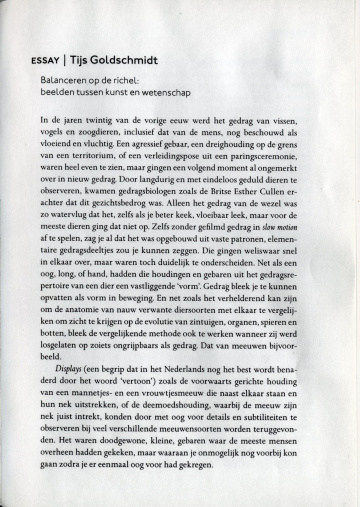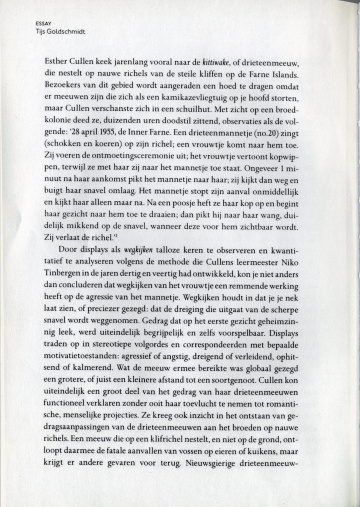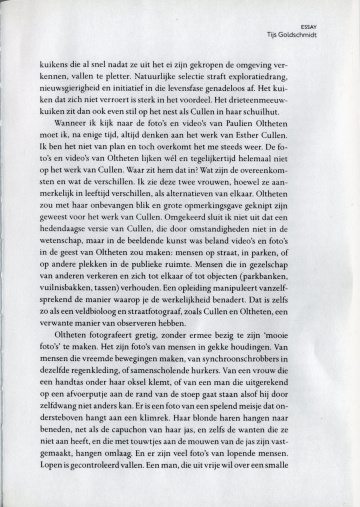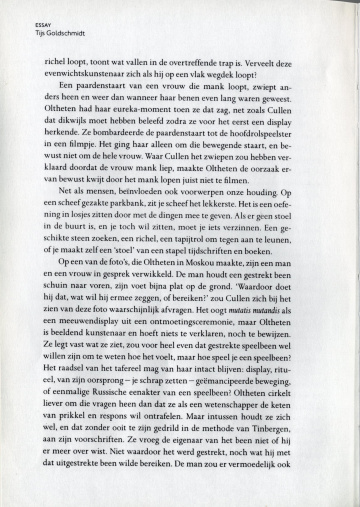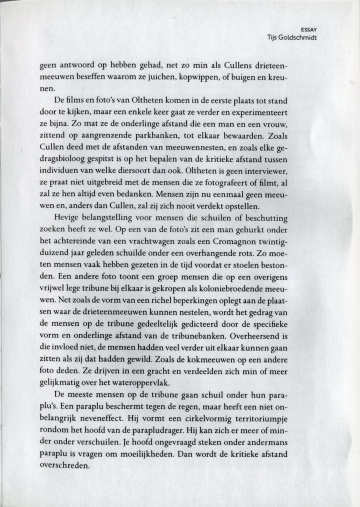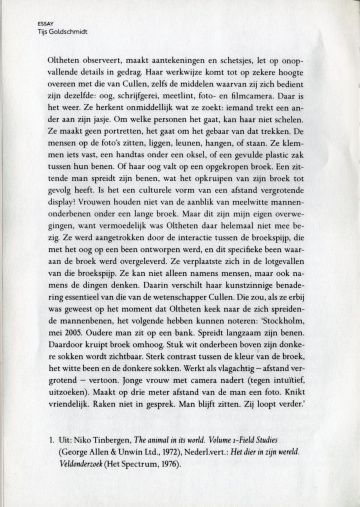Essay written by Tijs Goldschmidt.
Included in the book Theory of the Street, Paulien Oltheten 2007 and essay bundel Kloten van de Engel, Tijs Goldschmidt in 2008.
In the 1920s, the behaviour of fish, birds and mammals, including humans, was still regarded as fluid and fleeting. An aggressive thrust, an intimidating stance on a territorial boundary or a seductive pose in a mating ceremony was seen but briefly, and a moment later had evanesced into a new behavioural pattern. By observing animals with infinite patience for sustained periods, behavioural biologists such as the British scientist Esther Cullen eventually established that this was a delusion. Only the weasel displayed behaviour so lightning-fast that it was like quicksilver even if one studied it more intently, but that did not hold true for the majority of animals. Even without playing back filmed footage in slow motion one could ascertain that behaviour was composed of set patterns – elementary behavioural particles, you might say. And though these patterns were subject to swift transitions they could be clearly distinguished. Just like an eye, lung or hand, these postures and gestures from an animal’s behavioural repertoire had a fixed ‘form’. It seemed that behaviour could be understood as form in motion, and in precisely the same way it can prove enlightening to compare the anatomy of closely related animal species in order to gain insight into the evolution of the senses, organs, muscles and bones, the comparative methodology also seemed to work when applied to something as impalpable as behaviour – the behaviour of kittiwakes, for example.
Displays like the forward posture of a male and female gull standing side by side and stretching their necks, or the hunched, submissive posture in which the gull withdraws its neck, could be found in various species of gull by observing with careful attention to detail and subtleties. They were perfectly commonplace little gestures that most people had failed to notice, but something you could hardly miss once you had developed an eye for it.
Esther Cullen devoted many years to observing nature, primarily watching the three-toed kittiwake that nests on the narrow ledges of the precipitous cliffs of the Farne Islands. Visitors to this wonderful region are advised to wear a hat, because there are gulls that throw themselves at people’s heads like kamikaze pilots. Instead of donning a hat, Cullen sought cover in a hide. From a fine vantage point overlooking a nesting colony she spent thousands of hours sitting perfectly still to gather observational data such as the following: ‘April 28, 1955. The Inner Farne. A male Kittiwake (No. 20) “sings” (Chokes) on his ledge; a female visits him. They perform the meeting ceremony; the female shows Head Tossing, standing with her side to the male. Approximately 1 minute after her arrival the male pecks at her; she then faces away and turns her beak down. The male at once stops his attack, and just looks at her. After a while she lifts her head and begins to turn her face towards him; he now grabs her cheek, obviously aiming for her beak as it becomes visible to him. She leaves the ledge.’*
From observing displays such as ‘Facing Away’ countless times and analysing them quantitatively in accordance with the methodology that Niko Tinbergen, Cullen’s teacher, had devised in the 1930s and ’40s, the only reasonable conclusion was that the female’s Facing Away has a calming effect on the male’s aggression. Facing Away involves showing your neck or, put more precisely, dispelling the threat that emanates from the sharp beak. Behaviour that on the face of it seemed unfathomable eventually became intelligible and even predictable. Displays occurred in stereotypical sequences and corresponded with specific motivational circumstances: aggressive or submissive, threatening or seductive, provocative or appeasing. Globally speaking, what the gull achieved was a greater or smaller distance to a bird of the same species. In the long run Cullen could functionally explain much of the behaviour of her kittiwakes without resorting to romantic, human projections. She also gained insight into the origins of the behavioural adaptations of kittiwakes brooding on narrow ledges. A gull that nests on a cliff ledge rather than on the ground avoids the fatal attacks of foxes on eggs or chicks but is confronted with other dangers. Curious kittiwake chicks that explore the surroundings soon after they emerge from the egg will tumble to their deaths. Natural selection ruthlessly punishes the urge to explore, curiosity and initiative at this stage of the kittiwake’s life. The chick that does not stir whatsoever has a big advantage, so it remains as immobile on the nest as Cullen in her hide.
When I look at the photos and videos by Paulien Oltheten I cannot help my thoughts turning to Esther Cullen’s work. Though this is not intentional it happens to me time and again. The photos and videos by Oltheten seem similar yet completely dissimilar to Cullen’s work. Why is that? What are the similarities and what are the differences? I see these two women, though they are highly dissimilar in age, as alternatives for one another. With her open-minded gaze and observational acuity, Oltheten would have been ideally suited to carry out Cullen’s task. Conversely, I cannot rule out that a modern-day version of Cullen who by force of circumstance had ended up working in the visual arts rather than science would make videos and photos along similar lines to Oltheten: capturing people in the street, in parks or elsewhere in the public domain, people who mingle and relate to one another or to objects (park benches, rubbish bins, bags). Training obviously moulds how one deals with reality. That is the case even when a field naturalist and a street photographer, such as Cullen and Oltheten, have an analogous manner of observation.
Oltheten shoots photographs rapaciously, without thinking about making ‘pretty pictures’. The result is photographs of people in strange poses, people who make strange moves, of synchronized scrubbers in identical rainwear or a huddle of people squatting on the ground, of a woman who clamps a handbag under her arm or of a man who goes and stands precisely on a drain cover at the edge of the pavement as if by force of compulsion. There is a photo of a girl at play who is hanging upside down on a climbing frame. Her blonde hair hangs down, just like the hood of her coat, and even the unworn mittens that are attached to the sleeves of the coat by thin cords hang downward. There are also many photos of people walking, an action that equates to controlled falling. A man who is voluntarily walking along a narrow ledge provides a superlative demonstration of falling. Does it bore this balancing artist to walk on a flat surface?
The ponytail of a woman who walks with a limp swishes back and forth in a different way to the ponytail of someone whose legs are of equal length. Oltheten had her ‘Eureka!’ moment when she noticed this, as Cullen must have experienced frequently when she first recognized a display. Oltheten thrust the ponytail into the lead role in a short film. That swaying ponytail was all that mattered to her; not the whole woman. Whereas Cullen would have explained the woman’s limp as the causation of the swishing, Oltheten deliberately obscured its origin by not filming the limp.
Objects affect our demeanour just like people. The most comfortable way to sit on a slanting park bench is to sit lopsided. It is an exercise in finding a relaxed sitting position by yielding to the object. If there isn’t a seat nearby but you still want to sit down then you have to be creative: you look for a suitable rock, a ledge or a roll of carpet to perch on or lean against, or you make yourself a ‘stool’ from a stack of magazines and books.
In one of the photos that Oltheten shot in Moscow, a man and a woman are engrossed in conversation. The man extends his leg at an angle, his foot flat on a ledge. ‘What makes him do that and what does he want to say or achieve by it?’ is what Cullen would probably have wondered on noticing this scene. It looks, mutatis mutandis, like a gull display from a meeting ceremony, but Oltheten is a fine artist and is not obliged to explain or prove anything. She records what she sees, would like to be that outstretched leg just briefly in order to know how it feels, but how do you act being a playful leg? As far as she is concerned the riddle of the scene can be left intact, whether it be a display, a ritual, a movement – bracing oneself – that is emancipated from its origins, or a one-off Russian one-act play for a playful leg. Oltheten prefers to skirt around these issues rather than endeavour to disentangle the sequence of cause and effect like a scientist. Though she has never being inducted in Tinbergen’s methodology she still employs its precepts. She refrained from asking the leg’s owner whether he had any light to shed on the matter – neither the reason for extending his leg nor what he hoped to achieve with that extended leg – though this still piques her curiosity. The man would probably have been at a loss for an answer, as unaware as Cullen’s kittiwakes as to why they Mew Call, Head Toss or Bow-and-Moan.
The films and photos by Oltheten are primarily the product of looking, but occasionally she goes further and almost conducts experiments. For example, she measured the distance maintained by a man and a woman seated on adjacent park benches, in the same way as Cullen measured the distances between gulls’ nests and like every other ethologist who is eager to ascertain the critical distance between individual members of every species on the planet. Oltheten is not an interviewer and does not talk at length with the people she photographs or films, though she will always thank them. This is for the simple reason that people are not gulls and, unlike Cullen, she will never conceal herself.
Oltheten does, however, display an acute interest in people who hide or seek shelter. One of her photos captured a man sitting on his haunches beneath the rear end of a lorry, in the same way a Cro-Magnon man would have sought shelter under overhanging rocks some 20,000 years ago. People must have sat like this habitually in the days before there were chairs. Another photo shows a group of people who have huddled together on the otherwise well-nigh empty stands of an amphitheatre, like gulls at a nesting colony. In the same way the shape of a ledge imposes limitations on the sites where kittiwakes can brood, the behaviour of the people on the tribune is to a certain extent dictated by the specific form of the amphitheatre’s benches and the distance between them. That effect is not predominant, and the people could have sat much further away from each other if they had wanted to, like the black-headed gulls in another photo, which are floating in a canal but have spread themselves fairly evenly across the expanse of water.
Most of the people on the stands are sheltering under their umbrellas. An umbrella protects from the rain, but has a side effect that is not insignificant. It forms a circular little territory around the head of the umbrella bearer. He can hide himself beneath it to a greater or lesser degree. Sticking your head under someone else’s umbrella uninvited is asking for trouble: it transgresses the critical distance.
Oltheten observes, takes notes and makes little sketches, and notices inconspicuous behavioural details. Her methodology corresponds with Cullen’s to a certain extent, and even the means she uses are the same: the eye, writing materials, a tape measure, photo and video cameras. There it is again! She spots what she is looking for in an instant: someone tugs on somebody else’s jacket. Who these people are makes no difference to her: she is not making portraits; it is about the gesture of tugging. The people in the photos sit, lie, lean, slouch or stand. They clasp onto something: a handbag under an armpit or a full shopping bag between their legs. Or she notices a trouser leg that has ridden up the wearer’s leg: a seated man spreads his legs, which results in his trousers riding upward. Is it a cultured form of a spacing-out display? Women don’t like the sight of men’s mealy white lower legs under long trousers. But these are my personal ponderings, because Oltheten was probably not even remotely interested in this. Her eye was drawn by the interaction between the trousers, which were designed with legs in mind, and this specific human leg to which the trouser leg was subjected. She imagined herself in the ups and downs of that trouser leg. Besides empathizing with people she can also imagine herself in the place of things. That is where her artistic approach is fundamentally different to the methodology of Cullen the scientist. If Cullen had been looking on as Oltheten observed the man’s legs spreading akimbo then she would have jotted down the following: ‘Stockholm, May 2005. Older male sitting on a bench. He slowly spreads his legs, causing his trouser leg to ride up his leg. A section of white lower leg becomes visible above his dark socks. Stark contrast between the colour of the trousers, the white leg and the dark socks. Functions as a flag-like – spacing-out – display. Young woman with camera approaches (counterintuitive, requires figuring out). She takes a photo of the man from a distance of 3 metres. Nods amicably. They do not converse. Man remains seated. She walks on.’
* Niko Tinbergen, The Animal in its World. Field Studies, Vol. 1, London: George Allen & Unwin Ltd., 1972.
